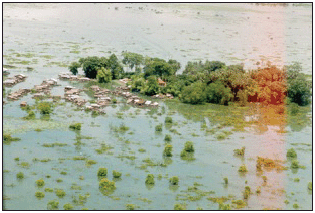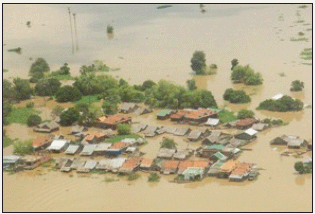6. Summary of the 2008 country reports
6.1 Cambodia
General situation
The annual report of the National Committee for Disaster Management (NCDM) for 2008 indicates there was little or no flood damage in the country during the year that could be linked to hydrological conditions along the Mekong mainstream, the Bassac and in the Tonle Sap Basin. Flood warning levels were not exceeded at any time. The only flood losses arose from flash flooding caused by a series of tropical storms during the latter part of September in Preah Vihear, Kampong Thom and Bantay Meanchey Provinces which damaged about 10 500 hectares of crops, mainly rice. The NCDM estimate of the cost of the associated damage is US$5.7 million, or about US$550 per hectare inundated. The figure for 2008 is below the average annual financial loss and less than 4% of that arising from the most extreme event of recent decades which took place in 2000:
Figure 6.1: Cambodian
flood situation in 2000, the most
extreme conditions of recent decades. Compared to this,
the situation in 2008 was one of the least damaging of
recent years with water levels along the Mekong, Bassac
and in the Tonle Sap system not reaching the alarm stage
at any time.
| Year | National
flood damage (US$ million) |
| 2000 | 161.0 |
| 2001 | 36.0 |
| 2002 | 12.5 |
| 2003 | no data |
| 2004 | 55.0 |
| 2005 | 3.8 |
| 2006 | 11.8 |
| 2007 | 9.1 |
| 2008 | 5.7 |
Lessons learnt
Since minimal flood damage was reported for 2008 no direct lessons can be drawn specific to the year’s events. The general observations and recommendations made in previous years continue to apply, however. In the main these emphasize the need for a stronger financial commitment to national disaster management and improved inter-agency coordination. Specifically it is recognized that:
- There is a lack of systematic flood preparedness planning at the provincial, district and commune levels.
- At the national level there is poor coordination between the institutions and agencies concerned with disaster management.
- Hydrometric monitoring in general and during flood events in particular requires the appropriate levels of funding. Financial support for the operation and maintenance of the recording network is also inadequate.
- Effective disaster management should be based on a continuous process of data assembly and analysis including mapping areas at risk and continuously developing and testing mitigation measures. While of significant benefit the momentum and technical expertise developed during the course of short term internationally funded projects is not often sustained due to a lack of ongoing financial support. The design and implementation of such projects also requires improved coordination such that repetition is avoided and funds used in a more optimal manner.
Choose a newsletter:


